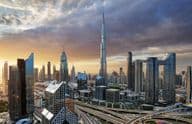UAE's Quirky Summer Weather: Dust Storms Await

UAE's Quirky Summer Weather: Dust Storms Await
Residents of the United Arab Emirates have been facing unusually changeable weather in recent days: dust storms, hazy visibility conditions, occasional rains, and temperature drops characterized the summer in the regions of Abu Dhabi and Dubai. According to the meteorological service's forecast, however, the relief is only temporary—the true heat of summer will soon return and may become even more intense.
What is the origin of this changeable weather?
The current weather situation is caused by several interacting atmospheric systems. The low-pressure zone arriving from the east, humid air masses, and the northward movement of the so-called Intertropical Convergence Zone (ITCZ) jointly induced the temperature drop, dust storms, and thunderstorms.
The ITCZ is a tropical zone where the northern and southern trade winds meet, raising warm, moist air, from which storm clouds often form. In July and August, this zone shifts northward, potentially affecting the weather on the Arabian Peninsula.
Where did the extraordinary weather appear the most?
The dust storms significantly reduced visibility around Abu Dhabi and Dubai, particularly in the Suweihan area, on Sunday and Monday. On Tuesday and Wednesday, a mild cooling was experienced with temperatures dropping by 4-5°C in some places, especially along the western coastline. The heaviest rains were recorded in Dubai's Margham district, Abu Dhabi's Al Dhafrah region, as well as in various parts of Al Ain—such as Umm Ghaffa, Al Faqa, and Khatm Al Shiklah areas.
Authorities have issued orange and yellow alerts in certain areas, warning residents about potentially hazardous weather phenomena.
What can be expected in the coming days?
According to the meteorological center, a brief period of calmer weather is expected in the middle of the week, but another active period may arise between July 24-26. This change will come with a shift to southern winds, increasing humidity, and rising temperatures—potentially reaching up to 49°C in some areas.
Convective cloud formation—which often leads to intense rain or hail—could reappear, primarily on the outskirts of Dubai (e.g., around Marmoom, Expo City areas), as well as in more remote parts of Liwa and Al Dhafra.
What should be noted?
Such unstable summer weather periods are not uncommon in the UAE, especially between mid-July and mid-August. Due to dust storms, visibility conditions may deteriorate, so motorists are advised to exercise increased caution and avoid outdoor activities that are highly sensitive to air quality. Rain and wind storms could also cause temporary power outages or traffic disruptions.
Summary
The UAE’s summer weather remains highly dynamic: milder days will be followed by another hot and dusty period. Those who can, should keep an eye on the meteorological service's forecasts and prepare for rapidly changing conditions, especially around July 25-26.
(Source: National Centre of Meteorology (NCM) communication.)
If you find any errors on this page, please let us know via email.


